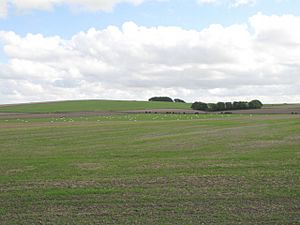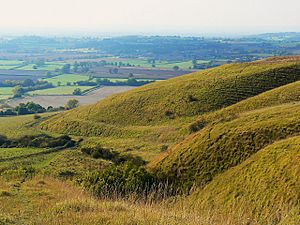Battle of Roundway Down facts for kids
Quick facts for kids Battle of Roundway Down |
|||||||
|---|---|---|---|---|---|---|---|
| Part of First English Civil War | |||||||
 Roundway Down |
|||||||
|
|||||||
| Belligerents | |||||||
| Commanders and leaders | |||||||
| Lord Wilmot Sir John Byron Earl of Crawford Lord Hopton |
Sir William Waller Sir Arthur Haselrig |
||||||
| Strength | |||||||
| 1,800 horse | 2,500 horse c 2,500 foot 8 guns |
||||||
| Casualties and losses | |||||||
| Minimal | 600 killed 1,200 captured |
||||||
The Battle of Roundway Down happened on July 13, 1643. It was fought near Devizes, in Wiltshire, during the First English Civil War. This war was a big fight between the King's supporters (called Royalists) and the Parliament's army (called Parliamentarians).
Even though the Royalist cavalry was outnumbered, they won a huge victory. They were also tired from riding all night from Oxford. This win was very important for the Royalists. It gave them control of South West England. Two weeks later, they captured the port of Bristol. This allowed them to connect with their friends in Ireland.
Contents
What Led to the Battle?
A few days before Roundway Down, on July 5, 1643, another battle happened. It was called the Battle of Lansdowne. Sir Ralph Hopton led the Royalists, and Sir William Waller led the Parliamentarians. The Royalists won, but they lost many cavalry soldiers and horses.
Their supplies were also destroyed when an ammunition cart exploded. This left Hopton badly hurt and unable to see for a while. A popular Royalist leader, Sir Bevil Grenville, was also killed. This made the Royalist soldiers, many from Cornwall, feel very sad. They were in a difficult spot.
The Royalists Need Help
Hopton's army needed more soldiers and supplies. They decided to go to Oxford, which was their wartime capital. They left Lansdowne and arrived in Chippenham on July 7. Waller's Parliamentarian army was still strong. They quickly got new soldiers from Bristol.
Waller saw a chance to defeat Hopton. He left Bath with 5,000 troops. He reached Chippenham on July 9.
The Chase to Devizes
As Waller's army got closer, Hopton marched south to Devizes. Waller followed him. Waller's army took control of Roundway Down. This was a high area about 2 kilometers north of Devizes.
The Royalists in Devizes were low on supplies and outnumbered. They decided that Prince Maurice and 300 cavalry would ride to Oxford. They would get help. Hopton and 3,000 Cornish foot soldiers would stay and defend Devizes. Maurice left at midnight on July 10. He reached Oxford the next morning.
Most of the Royalist army was away. But Lord Wilmot quickly gathered 1,500 cavalry. He then set out for Devizes with Prince Maurice and his men.
The Siege of Devizes
On July 11, Waller moved his army from Roundway Down. He placed them on the east side of Devizes. He set up cannons on Coatefield Hill to attack the town. Hopton tried to gain time by asking for a truce to talk.
While the Parliamentarians waited, their cavalry caught a Royalist convoy. This convoy was carrying gunpowder and ammunition for Hopton. They captured 200 Royalist soldiers and the wagons.
The Fight for Devizes
On the morning of July 12, Waller stopped talking. He began his attack. First, his cannons fired at the town. Then, his foot soldiers attacked the defenses. There was fierce fighting for hours. But the Royalists held onto Devizes.
Early the next morning, Wilmot's relief force got close to Roundway Down. They fired cannons to let Hopton know they were coming. Waller then stopped the siege. He marched his army north to stop Wilmot. When they reached the high ground, Waller put his foot soldiers and cannons in the middle. Waller led the cavalry on the left. Sir Arthur Haselrig led the cavalry on the right.
The Battle of Roundway Down
The Royalist cavalry was split into three groups. Wilmot was in charge overall and led the left group. Sir John Byron led the right group. The Earl of Crawford was in reserve.
Even though they had ridden all night, Wilmot attacked right away. He caught Waller's army off guard. Haselrig's soldiers, known as "London lobsters," were in an exposed position. Haselrig tried to get his men ready. But he pulled back when he saw Byron getting ready to attack. He rejoined the rest of Waller's cavalry.
As Waller moved down the hill, Byron kept attacking. Wilmot and Crawford's reserve group helped him. Waller's foot soldiers couldn't fire their guns. They were afraid of hitting their own men. The Parliamentarian cavalry was quickly pushed off the field.
The Royalists chased them. Some Parliamentarian soldiers rode off the edge of a steep cliff. This area later became known as "the Bloody Ditch."
The Parliamentarians Retreat
Now, Waller's foot soldiers were alone. Plus, 3,000 Royalists from Devizes were coming from behind them. Waller told his foot soldiers to form defensive squares. They started to retreat towards the northwest.
After about an hour, Byron's cavalry came back from their chase. They captured the Parliamentarian cannons. They turned the cannons on the retreating enemy. This quickly made the Parliamentarian soldiers break apart. They ran in all directions. Many were killed by Wilmot's men. Waller and the rest of his cavalry escaped towards Bristol. The remaining Parliamentarian soldiers had to surrender.
After the Battle
The Parliamentarian army in the west was almost completely destroyed. About 600 soldiers were killed. Another 1,200 were captured. The Royalists also took their cannons, wagons, gunpowder, ammunition, and supplies.
In his report, Byron said that very few Royalists were killed. He noted that many officers and "gentlemen" were hurt. This was one of the Royalists' most complete victories of the war. It gave them control of the southwest. Less than two weeks later, they captured the important port of Bristol. This helped them connect with their allies in Ireland.
The Royalists won a great victory. They had ridden over 60 kilometers directly into battle. Their 1,800 cavalry defeated a much larger force of 5,000 soldiers. This included cavalry, foot soldiers, and cannons. The Royalists had very experienced soldiers. Haselrig's "deplorable tactics" also helped the Royalists. He waited for Wilmot's charge, hoping his carbine fire would stop them. This was a common mistake by Parliamentarian cavalry leaders early in the war.
Waller's reputation as a military leader suffered because of this loss. However, historians say his leadership at both Lansdowne and Roundway Down was not at fault.
Today, Roundway is a small village. It is 2 kilometers north of Devizes. About 25 people live there. People are still discussing where to bury those who died in the battle.
Images for kids



